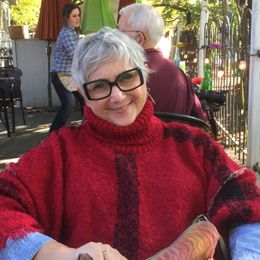The Trouble With the New Sally Field Movie
'Doris' may get the guy, but women over 60 get shortchanged
(This post originally appeared on Midcentury Modern.)
In the new movie Hello, My Name is Doris, Sally Field plays a woman in her sixties who falls in love with the new hunk in her office. The hunk, named John, happens to be half her age, and is played by Max Greenfield (Schmidt on TV's New Girl), whose winning smile reminds me of Ken Olin’s portrayal of Michael on Thirtysomething back in the '90s.
Greenfield’s smile is the best thing about this movie, but it’s not enough to save it. The problem is Field’s character — an amalgam of every stereotype of the sad spinsterhood rolled up into one vivid grotesquerie.
She lives in Staten Island, she has a cat, she wears her hair up in a big floppy bow, she’s a hoarder, she’s such a Facebook virgin that when she gets a notification chime, she recoils as if a gun went off, she needs two pairs of glasses to look at a computer screen, and her body language says “I wish I could shrink up into a little ball of fuzz and blend into the rug.”
She’s the one who’s going to snag the hottie.
A Certain Age
I saw the film last spring at the Montclair (N.J.) Film Festival. In the Q&A afterwards, between the film festival’s executive director Tom Hall and director/comedian Michael Showalter, there was a fair amount of congratulation and self-congratulation for Showalter making a film with a leading character who’s “a woman of a certain age.”
That phrase was actually repeated onstage several times, and then by someone in the audience asking a question, and the general consensus seemed to be that anybody who throws a bone to an actress over the age of 40 deserves a Nobel Prize.
The problem, though, is that Sally Field’s character is so cringeworthy (and yes I do get it, she grows over the course of the film) and the comedy so broad that the ratio of laughs to winces was, generously speaking, about 1 to 10.
How broad? Consider one of the movie’s peak scenes, in which Doris learns that John’s favorite band is playing in Williamsburg and decides to go so she’ll run into him. Her concert ensemble — presented as a huge laugh — is a ridiculous mismatched neon jumpsuit, her hair bow temporarily replaced with an oversized visor. Really, just imagine an outfit Richard Simmons discarded in 1979.
No Laughing Matter
And this outfit, Showalter insisted, was proof of how much he loves and respects this character: “She says a lot with what she wears.”
Looked at another way, Doris has made the cataclysmic character leap from milquetoast to eccentric. Hooray!
Yes, it’s a role for a “woman of a certain age.” Yes, there are wrinkles. Congratulations. But when there are so few portrayals of women in their 60s in Hollywood, we choose to make one that depicts an older woman as not just pathetic, but laughably pathetic? Now that’s sad.
We Can Do Better
A friend I spoke with after the screening made an interesting analogy. It would be like — she said — a director 50 years ago making a movie about an Uncle Tom figure. Sure, the director could argue, “It’s based on a real character. There reallywas a person exactly like this.” And maybe there was. But does he get credit for making movie about the black experience? Or would a lot of people be, justifiably, offended?
When I got home, it struck me: Amos and Andy. We’ve gotten beyond the limp wrist as a hilarious signifier for a gay person, and the shuffle-and-jive as a hilarious signifier for a black person. Director Michael Showalter said that Sally Field’s character was a real archetype. He’s wrong. It was a stereotype. Like so many others, it’s time to let it go.
https://www.youtube.com/watch?time_continue=2&v=L6vBnnryIug


